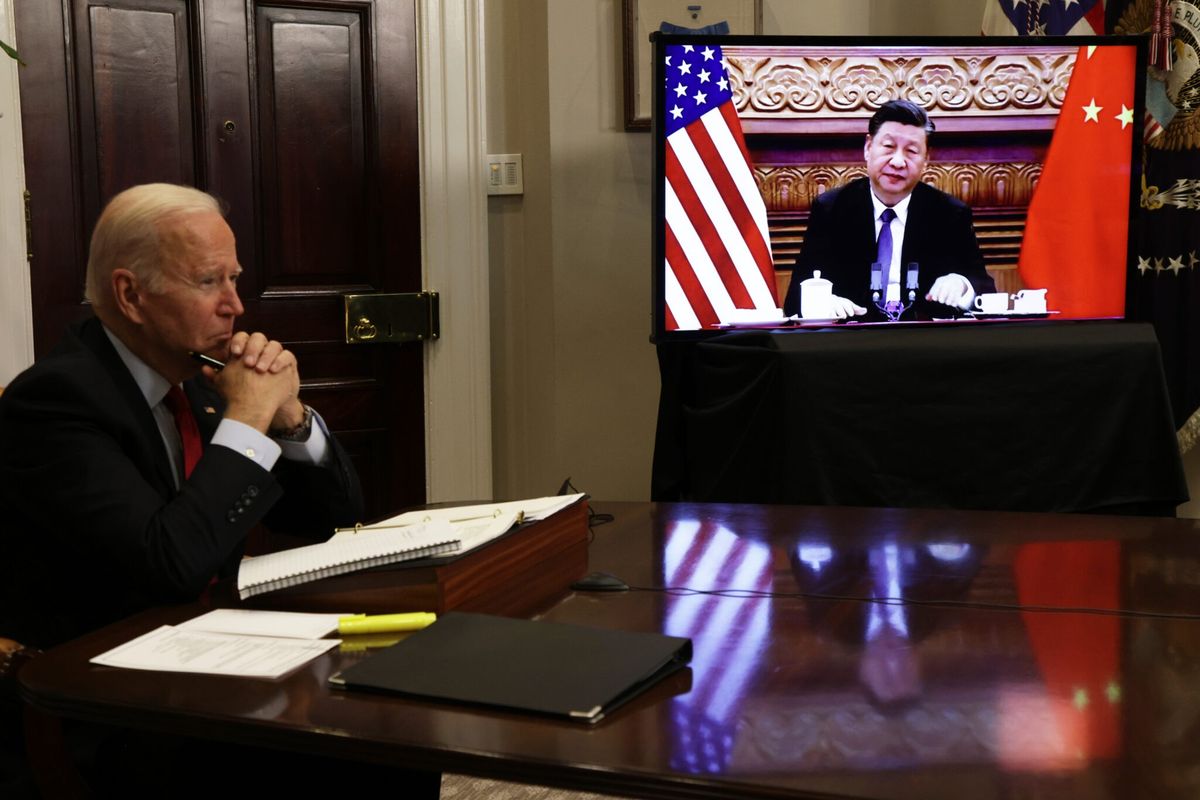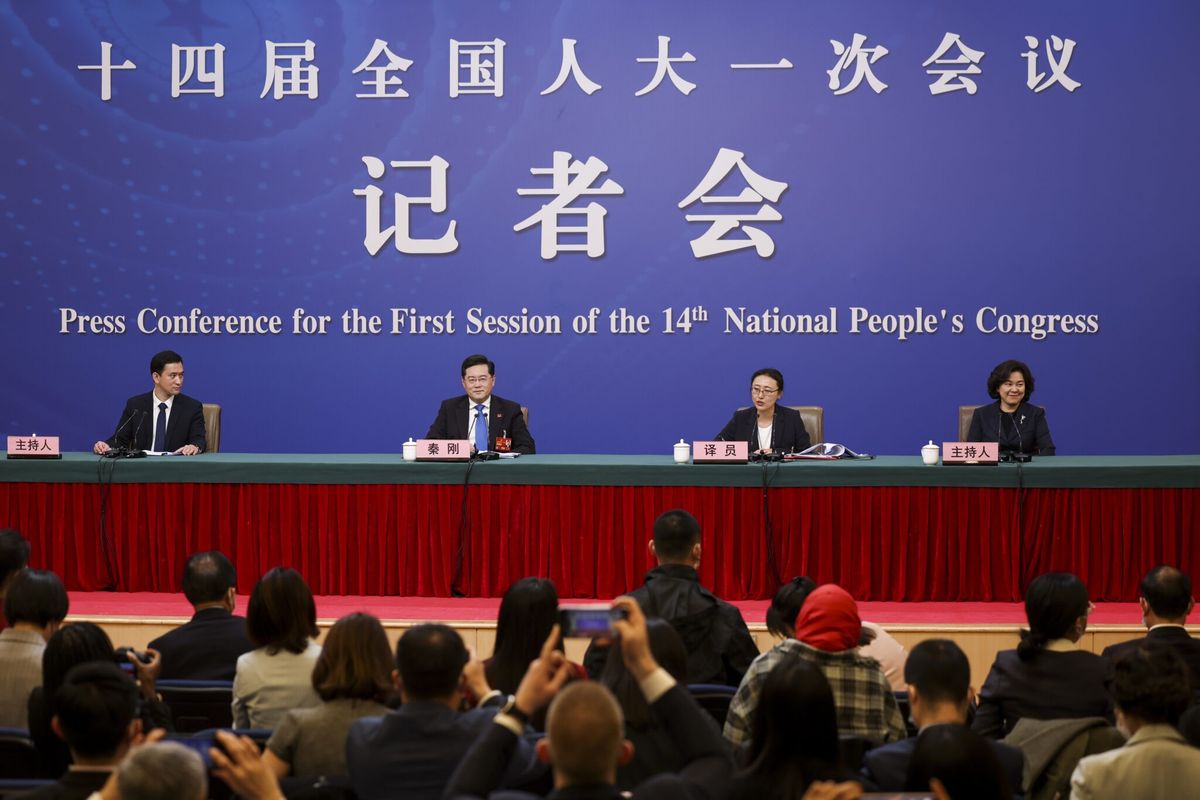EXPERT Q&A — The 2022 National Defense Strategy, which the DoD released in October, commits to promoting deep tech R&D in areas including directed energy, hypersonics, integrated sensing, and cyber, as well as seeding opportunities in biotechnology, quantum science, and advanced materials.
Cipher Brief Expert and former CIA Senior Executive Brett Davis, a founding partner of New North Ventures, talked with us about the trends and key features that he sees in the drive toward new advances in Deep Tech research and development. You can read the full Subscriber+ analysis here.
EXPERT Q&A
The Cipher Brief: Looking across the landscape of deep tech development, where do you see this sector playing an important role for intelligence and defense applications?
Brett Davis: There are several areas where I see rich opportunity for deep tech technology, especially artificial intelligence (AI) and machine learning (ML), and particularly in AI and ML-enabled deep data analytics as well as AI-ML-enabled robotics. They are huge now and they are going to continue to become more and more critical as we go ahead.
On the robotics side, I think we've all seen what's happening in Ukraine with drones and how effectively the Ukrainians have been using them, and then the Russians as well bringing them in. They've been using them to direct artillery support but there are many more possibilities. For example, a big concern would include being able to swarm drones on an aircraft carrier to overwhelm defensive systems, or to overwhelm a battle group or a team in the field. So this has been become very, very significant.
Robotics and autonomous systems, including subsea autonomous systems, are going to become more critical going forward, especially in connection with great power competition, specifically with China. But Russia is determined not to let us forget that they are a great power in their own minds that has to be reckoned with — take the Nord Stream pipeline, the explosions that happened there. Whether it was by ship or autonomous systems, being able to protect subsea pipelines, the global communications infrastructure, is essential. Over 90 percent of all communications globally flow through the subsea telecommunications net.
So the ability of the Russians and Chinese to fracture those is a serious concern and our ability to protect them is critical. Also, being able to map the oceans looking for rare earth minerals or just other minerals that are essential for power systems, for batteries and the wires for power transmission lines. Being able to get all that from robotic systems, combined with their applications in factories, on farms and across the board, being able to do things more effectively. In robotics, that is going to continue to become more important.
Then, big data analytics is going to continue to drive things. You'll continue to see a cross-pollination between what's happening in retail markets with what's happening on the national security side in connection with targeting.
You'll continue to see really high-end AI teams, companies that are leveraging what they learn in the government space and being able to use it commercially at scale and vice versa. I think we're going to continue to see greater flow between the commercial world and the defense and intelligence worlds, which I see as a good thing.
Get your 10-minute daily national security brief with Suzanne Kelly and Brad Christian by signing up for The Cipher Brief’s Open Source Report Newsletter or by listening to The Cipher Brief’s Open Source Report Podcast wherever you listen to podcasts.
Another technology that is super important and will become more so is cybersecurity, protecting critical infrastructure, not only, for example, systems in an F-35 aircraft, but also large-scale applications such as pipelines; remember what we saw a couple of years ago with Colonial Pipeline. Or the ability to protect our power grid. We're going to start seeing cybersecurity baked into regular products and systems. I’m talking about a more integrated solution that incorporates cybersecurity instead of cybersecurity being looked at by many companies as a cost center rather than revenue generating. If you're able to start pulling together an advertising tech or retail analytics capability that has cybersecurity or some version of security baked into it, that will become more important.
Another aspect on the cybersecurity side is how to better assess, handle, and get on top of the insider threat. Take, for example, high-end talent working in a company. This actually happened to a company where they had top-end engineers leave and go to a Chinese company, and they were able to still log back in and take a lot of the intellectual property from them. That’s one kind of insider threat. On top of that are software bills of materials, which allow you to manage the software supply chain.
So much open source code is out there, and so just now, the White House and DoD have come out with requirements that if you're going to be working with DoD contracts in particular, you need to validate and understand the legacy of where the open source code comes from and that it’s secure, that it's not code written by Russians or Chinese or North Koreans that has got back door traps in it. There's a lot of that and it is a real, real problem.
Then there is critical infrastructure, which is a broad tent and a key part of the national interest and national security. One of the areas I think is often overlooked and typically not written about in national security forums, and understandably so, is the financial infrastructure. When you look at the history of the country, finance and business goes back to the very beginning. In this connection, something that typically doesn't get talked about is dual use. I can understand that because dual use usually comes from a more militarized perspective when looking at warhead components and missile components that also can be used for civil purposes.
But when you look at it more broadly, such as what makes a country run, what is in the national interest, we’re talking about the economy. Business is what runs the country. It's the engine of the country, and I think we're mistaken if we don't recognize that and think of that as part of our critical infrastructure. For example, Wall Street, big banks and all that infrastructure that goes along with that sector is a key part of what allows people to go about their daily lives with a sense of predictability. The financial structure there is key.
Another aspect is on the space side. The commercialization of space is a great example of U.S. leadership coming together from the government, along with financiers and entrepreneurs. So you've got SpaceX, Virgin Orbit, Blue Origin, Rocket Labs. HawkEye360, another great example of a commercial company that has government and commercial sides as well. In space, the command and control of the spacecraft and being able to move data at speed and at scale is hugely important, and you have to be able to do it securely. There's still a lot of work that needs to be done there. Right now, if you are to go to a ground station that runs satellites — I don't care if it's NRO or a commercial company or wherever — there are so many different systems there that are not necessarily compatible with each other. Being able to maneuver among those systems is unwieldy and complex. So companies that are able to synthesize and integrate and move between different classification levels or levels of sensitivity are going to become more important and essential to running that critical infrastructure. Along with that, part of the critical space infrastructure, GPS, goes into everything, not just positioning, but of course with your phones, with timing.
Somewhere around 80 percent of the semiconductors produced globally right now come from principally one factory in Taiwan. That is a massive chokepoint and a pain point and a very massive national interest, national security dilemma. Good work is being done on that with the Chips and Science Act. Something that we need to continue to develop is not just very high-end chip design, but the actual construction of the plants where they’re made.
Another area within critical infrastructure is biotech. To be well ahead of the next pandemic - and there will be a next time and it's likely to be worse - whatever comes next, it's going to be critical that we are able to produce vaccines at scale and build whatever machines are needed to help keep people alive. That goes back to some of the engineering discipline as well. Biotech to be used in fuels and in reclamation of trash and so many things. There's a lot of stuff that's happening in the biotech field right now that sounds like pure science fiction, but it's actually being worked on in the lab and there is massive potential. The Department of Defense has been taking a significant look at how to get on top of that and what some of the trends are and what some of the science is that's going to be able to be engineered and to be used at scale.
The last thing I'll put out there as part of the critical infrastructure and one of the key things for energy optimization is nuclear power. There's more interest really beginning to be poured into making Small Module Reactors (SMR), being able to build much smaller versions of a nuclear power plant. It's one of the cleanest, most reliable and one of the safest fuels there is that doesn't require the amount of extraction out of the earth to build batteries or anything else. So, nuclear power is the most efficient of all the power sources pretty much by all measures when you look at it in terms of power output, size, weight, the extractive aspect and safety across the board.
The Cipher Brief: In previous comments, you’ve mentioned that Deep Tech sectors really need “Wernher von Braun types,” champions and groundbreakers for deep tech advances. Are you coming across such people and do you see areas in which such figures are likely to emerge?
Davis: I think it's likely to occur in all industries. There's a great book that just came out called Chip War, about the people who started semiconductors. There are a handful of folks that the author tracks right from the very beginning — Andy Grove of Intel, Noyce from Fairchild, Morita from Sony, and how they came through and really drove their industry. You look at any industry and there are a handful of people who were the real key drivers who made things happen.
This goes to where being able to have the policies and programs in place, including immigrants coming into the U.S., is important. They've come to this country, they've put their time and effort into education and learning. Look at Ukraine and what's happening there right now and all the innovation with drones and data analytics that go along with that. I think you're going to find some of the top AI talent for AI-enabled autonomous systems are going to be Ukrainians. If I headed an AI company working on AI-enabled robotics, AI-enabled data analytics, AI-enabled autonomous systems, I would be looking hard at who some of the most innovative people are in Ukraine and trying to bring them into the company in some capacity.
The Cipher Brief: Have you found that U.S. government policies and programs promote bringing in the sort of talent you're describing? Are they cumbersome or are they becoming better?
Davis: They're very cumbersome. I think in the last several years, it's become more difficult, but I think when you start looking at the high tech, they're going through the process. I think the government has to be smart in the approach it takes to immigration. There are obviously people that we don't want in, and so better things need to be done on that. But at the same time, we need to do a better job of being able to get into the country the top tier talent who are going to help launch companies that are working in the national interest, the Wernher Von Braun types.
The Cipher Brief: The vetting issue you're talking about in the context of immigration and refugees probably also applies to some degree in the back-and-forth transition from private to public sector — sharing talent, especially in the intel community, sometimes across very strict security limitations.
Davis: I think there's been a lot of good work that's been happening in that area over the last several years. I think more can be done. Another way to do it is for companies to have a foreign office – maybe an office in Ukraine, or Poland or another country where we're able to work with the available talent. Ideally, we would be able to get them into the U.S. and they become U.S. citizens. That's the goal, but a good intermediate step is to set up an office in another country where we're able to meet with the talent. So, for example, people who are writing code on how to do data and sensor fusion, the open source code where we talked about regarding the software bills of material. As long as we're on top of that and cybersecurity is baked in, you're good to go. Good companies and good leaders will find a way to do that.
The Cipher Brief: Another topic you’ve mentioned is the creation of teams that join together financiers, entrepreneurs, and operations people, and about Deep Tech enterprises being more intentional about taking these diverse disciplines and having them collaborate and cooperate with each other.
Davis: If you look at the space industry right now that's happening at scale. You have private financiers and extraordinary entrepreneurs and innovators coming in. You've got great engineering talent. You have the best of government policies and procedures coming together. Over the last several years, the Air Force with AFWERX (a Technology Directorate of the Air Force Research Laboratory) has done an incredible job at looking at how to fast track small companies and pull them into the DoD ecosystem.
The Cipher Brief hosts expert-level briefings on national security issues for Subscriber+Members that help provide context around today’s national security issues and what they mean for business. Upgrade your status to Subscriber+ today.
In-Q-Tel, under the leadership of Gilman Louie, who is now leading the America's Frontier Fund, is another tremendous example of doing exactly that. The nonprofit American Freedom Fund is looking at raising $2 billion of assets under management to be able to invest in deep tech for the U.S. That effort envisions pulling together all the people we just talked about in different centers of excellence across the country and the manufacturing belt so that the country as a whole is resilient and we're able to lift up the productivity and wealth of people across the country. The concept sees companies being able to really thrive in Ohio, upstate New York, or wherever else where there's a history of having worked in the industrial age centers of excellence for builders that are there.
I think we're turning the corner on this and it's happening. We also see venture capital firms that are focused on working in the national interest that see that it's not only good to work for national security, but there's also a lot of wealth that can be generated at the same time – the growth of wealth and economic security equals national security. It used to be thought that those two things were mutually exclusive. Now, I think people are realizing that they're one and the same and you can and should do both. The companies that are able to be “ambidextrous” in that way are going to completely outpace and outstrip those that only do commercial work.
Read more expert-driven national security insights, perspective and analysis in The Cipher Brief













